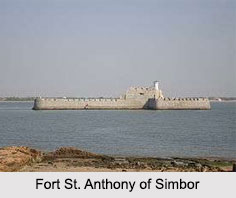 Fort St. Anthony of Simbor is a small ruined fort located on a small island in the bay of Simbor, about 25 km east of Diu. It was subsidiary to the Diu District that was established by Portuguese people in the pre British era in 1722 to suppress the predatory activities of pirates along the coast. This is one of the most important forts in Daman and Diu.
Fort St. Anthony of Simbor is a small ruined fort located on a small island in the bay of Simbor, about 25 km east of Diu. It was subsidiary to the Diu District that was established by Portuguese people in the pre British era in 1722 to suppress the predatory activities of pirates along the coast. This is one of the most important forts in Daman and Diu.
History of Fort St. Anthony of Simbor
Fort St. Anthony of Simbor was built at a time when the Portuguese presence in Asia was declining. This is one of the last fortifications built in India by the Portuguese. The rulers of Gujarat and Portuguese jointly made this structure to defend Diu against any possible invasion. The fort was once connected to the land by an underground tunnel, which is however in ruins now.
Its construction had been encouraged by the predatory activities of pirates along the northern shores of the Arabian Sea, especially in the Gulf of Cambay. In 1722, the Governor of Diu, Luis de Melo Pereira, ordered an assault against that position. After having captured it and burned the pirates" vessels, the Portuguese then decided to develop the existing installation into a defensive position which was renamed as "Forte Santo Antonio de Simbor".
Structure of Fort St. Anthony of Simbor
Fort St. Anthony of Simbor is constructed in the form of a square, with the stone walls, inside the remains; there are the ruins of a Chapel. A small chapel dedicated to St. Anthony of Padua was erected inside the island fortification.
Present Condition of Fort St. Anthony of Simbor
The fort was completely abandoned following the departure of the Portuguese in 1961 and the structure continued to deteriorate, with large sections of the stone wall eventually collapsing. This fort is now originally under the renovation for the tourists by the authorities of Daman and Diu.
This article is a stub. You can enrich by adding more information to it. Send your Write Up to content@indianetzone.com.



















